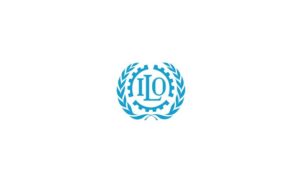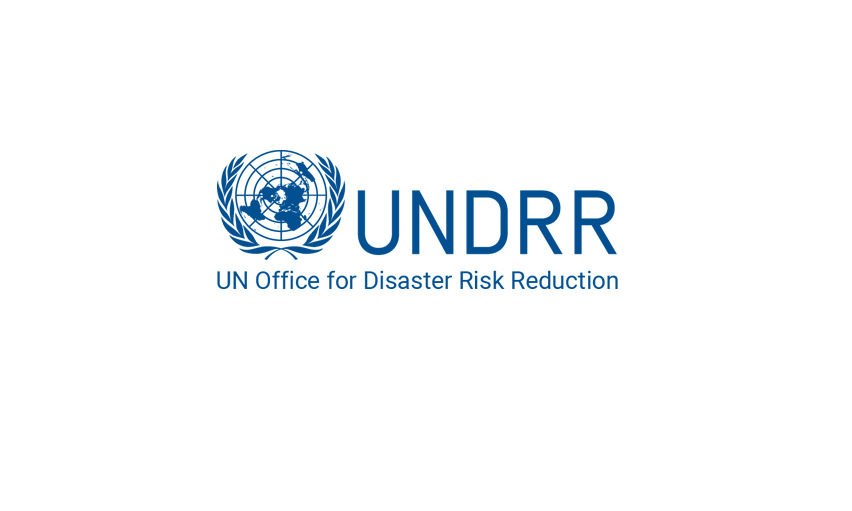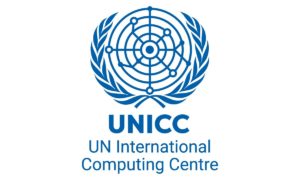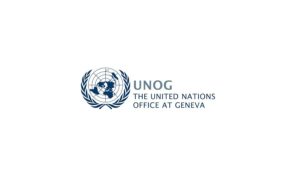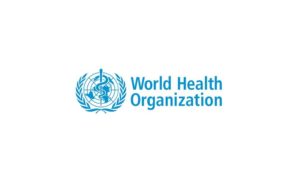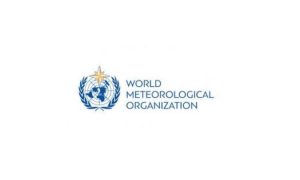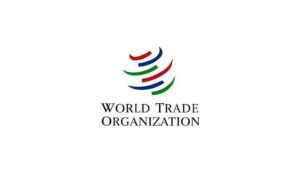Update
Greening International Geneva
Since the founding of the Red Cross in 1863, Geneva has evolved considerably as one of the foremost centers of global governance. Today, Geneva is home to the world’s highest concentration of international organizations and diplomatic missions which, along with the hundreds of non-governmental organizations headquartered in the region, form an exceptional density of global actors known as International Geneva. With the support of the host country and local authorities, and also from UN Greening the Blue, various actions are being taken to reduce the ecological footprint of these institutions.
The host country, Switzerland, the host city and canton of Geneva, the United Nations Environment Programme and the Geneva Environment Network stand ready to assist efforts of institutions to reduce the ecological footprint of their activities in Geneva.
Greening the UN System: Sustainable United Nations
The UN’s journey towards climate neutrality began on 5 June 2007 when UN Secretary-General Ban Ki-moon publicly called on all UN agencies, funds and programmes to ‘go green’ and become climate neutral.
In October 2007, the Chief Executives Board for Coordination (CEB) approved the United Nations Climate Neutral Strategy that committed the UN system to measure, reduce and offset greenhouse gas (GHG) emissions from facilities, operations and travel.
In 2015, UN organizations committed to becoming climate neutral by 2020, using the UN Roadmap towards Climate Neutrality by 2020, and in 2019, the CEB endorsed the Strategy for Sustainability Management in the United Nations System (2020–2030) to intensify efforts to combat climate change through internal sustainability strategies.
Coordinating the “going green” work across the UN System is the responsibility of the Sustainable United Nations (SUN) facility, based in Geneva.
Greening the Blue Report
UNEP, in collaboration with hundreds of UN personnel from across the UN System, annually collects and analyses information provided by entities on their environmental impacts and publishes this data and case studies in the Greening the Blue Report.
The 2023 edition, which was released on 21 December 2023, provides data on 2022. Greening the Blue Report 2023 highlights the environmental impacts of over 308,000 personnel in 57 entities across Headquarters, field offices and operations on the ground. The report also includes a case study from a UN entity on each of the environmental impact areas and management functions Major measured outcomes include 7 UN entities that have met or exceeded the criteria for implementing an Environmental Management System (EMS), with an additional 15 entities approaching the criteria; 24 out of 29 organizations that have implemented formal sustainable procurement policies in their procurement processes, and notably in 2022, 31 entities have environmental training available for their staff.
Sustainable United Nations & Geneva Environment Network Briefing | Findings of the Greening the Blue Report 2023
On 9 February 2024, Sustainable United Nations and the Geneva Environment Network will host a briefing presenting the findings of the Greening the Blue Report 2023. → Register and find further information
Various UN institutions have their headquarters in Geneva. Their environmental profile is available on the Greening the Blue website.
Learning: Greening the Blue Tutorial
The Greening the Blue Tutorial is designed for UN personnel to provide training on environmental sustainability at the UN system. The tutorial highlights the work that’s underway across the UN system to improve its environmental performance and provides helpful advice on how each person can contribute to that effort, by calculating and reducing their own work-related footprint. By being open for use by all, the tutorial also helps demonstrate the UN’s commitment to its environmental sustainability mission and provides advice to anyone outside the UN system wanting to learn how to reduce their workplace carbon emissions.
Best Practices, Tools, and Guidance
Since the UN’s journey towards climate neutrality and environmental sustainability began in 2007, UNEP, SUN, and the IMG members have collaboratively produced a variety of resources that help guide the UN System and entities in achieving their environmental commitments. The Sustainable UN provides and compiles best practices, tools, and guidance that can be used in their organizations and for any other interested person or entity who may find the resources to be useful.
Apart from the Greening the Blue Tutorial, other relevant resources include:
- The EMS Toolkit | This application was developed to support UN entities, funds and programmes in their endeavours to implement environmental management systems (EMS).
- Green Events Tool (GET) | The Green Events Tool (GET) is an integrated web-based assessment platform conceived and designed to evaluate the sustainability and environmental performance of events.
- Sustainable Procurement Online Training | The UN Development Programme offers specialized procurement training and certification to staff from the UN system, non-governmental organizations, international development financing institutions and their borrowers, and governments.
- and more!
Find a list of available resources for 2023 in this guide.
2050Today Initiative on Climate Action
The Permanent Mission of Switzerland launched the 2050Today climate action initiative, aiming at reducing CO2 emissions at the local level in Geneva, in cooperation with local authorities. As part of 2050Today, member institutions are to implement concrete measures to reduce greenhouse-gas emissions and measure their results. To multiply the impact of the common efforts, the 2050Today community provides a platform for sharing experiences, solutions and practices.
2050Today has three main goals :
- Foster CO2 emissions reduction : Measuring on regular basis the carbon footprint will greatly promote a rapid, continuous and measurable reduction of GHG emissions of the participating institutions as it will provide clarity for action.
- Enhance Cooperation : Sharing experiences, solutions and practices will foster and facilitate the implementation of efficient measures with a sense of solidarity and cooperation.
- Raise awareness : Leading by example will raise awareness among the personnel of the participating institutions and foster inclusive climate action within international Geneva.
Geneva, as the European headquarters of the United Nations, the headquarters of the IPCC, the headquarters of the World Meteorological Organization and the main centre for the implementation of sustainable development objectives, can be the symbol of concrete, measurable and visible action to reduce emissions. This proposal for action is addressed to all the institutions that make up the ecosystem of International Geneva (Permanent Missions, international organizations and NGOs).
2050Today initial entities – Permanent Missions of Denmark, Fiji, France, Mexico, Morocco, Rwanda, Slovenia, Switzerland, UNOG and UNEP-Europe – presented their 2019 carbon footprint on 27 October 2020, and invited all institutions of International Geneva to join the initiative. The national and local authorities support this initiative, which secretariat is now hosted at the University of Geneva.
The initiative now comprise around 60 members. New entities that are interested in the project should enter in contact with the secretariat of the initiative.
In December 2023, 2050Today launched a Charter establishing the common framework for the necessary enhanced climate action and other sustainable activities. Signatory institutions pledged to:
- Define guiding principles with objectives and targets to be set individually by each institution in accordance with its own climate references;
- Implement a wide range of concrete and specific actions through guidelines;
- Benefit from benchmarks for the assessment of the initial situation of every sector on which institutions decide to act;
- Design own action plans to reduce GHG emissions by setting individual targets based on its own climate benchmarks;
- Benefit from coordinated support providing targeted resources in terms of knowledge, monitoring and start-up funding;
- Promote greater visibility by jointly communicating the climate action of international Geneva.
Launch of the 2050Today Initiative
Sustainable Cooling System for International Organizations

Various international organizations buildings are connected to the Geneva-Lac-Nations’ (GLN) remote cooling network. Launched in 2009, this network allows their premises to be cooled and heated with deep water from Lake Geneva. UNOG, ILO, ICRC, WTO and WIPO are connected to this network. From 2022, the GeniLac © project will strengthen the GLN network and will cool and heat a larger number of buildings, from the city center to the airport area.
Greening CERN
In September 2020, CERN – the European Council for Nuclear Research – released its first Environment Report, which stresses its engagement towards sustainable research through different actions in the field of energy, greenhouse gas emissions, waste, water, biodiversity, environmental compliance, and technology. CERN is also taking into account the impact of radiation and noise on people living close to its experiment sites.
In November 2021, CERN published its second Environment Report, which covers the years 2019-2020 when the accelerator complex was in its second long shutdown, an opportunity for CERN to improve its environmental footprint on several levels. The report showcases CERN’s efforts in various areas, including direct greenhouse gas emissions reduction, local heat recovery projects, energy efficiency improvements, environmental reporting and communication, and more.
In December 2023, CERN published its third Environment Report, which covers the years 2021-2022 and outlines the Organization’s commitment to becoming a role model for environmentally responsible research and sets out concrete objectives for environmental stewardship.
Greening the Palais des Nations
Various actions in different sectors have been implemented at the Palais des Nations, such as:
- Energy: In 2014, solar panels have been installed on the roof.
- Heating: In 2008, the Palais des Nations has changed its heating system from fuel to natural gas, which produces less pollutants and carbon emissions. Moreover, new windows have been installed in 2014.
- Cooling: The Palais beneficiates of a climate-neutral cooling system from the Genève-Lac-Nations project.
- Mobility: Additional parking for bicycles and charging stations for electric cars have been installed.
- Environmental Management System (EMS): An EMS has been adopted, leading to a commitment on environmental protection and improved environmental performance.
- Climate-neutrality: The measurement of greenhouse gas emissions is realized each year in order to identify their sources and to find solutions to reduce them. Unavoidable emissions are compensated by purchasing Certified Emission Reductions.
- Water consumption: The Palais des Nations has decreased its water consumption by changing toilet flushes, putting sensor-activated taps and setting up an automatic system for the irrigation of the Ariana Park.
- Food system: The Palais des Nations has a goal of zero food waste and zero single-use plastics. Each month the production that has not been consumed is given to the food bank Partage. Concerning plastics, a replacement of plastic take-away containers by biodegradable ones and of plastics straws by biodegradable recycled paper straws have been implemented.
- Zero-waste: Waste sorting bins for recycling have been installed and in 2019, an EcoCorner has been created to collect batteries and plastic caps, among other things.
Greening ILO
When the International Labour Organization (ILO) was established in 1919, neither climate change nor environmental sustainability posed a threat to social justice. However, accelerating developments over the last decades have led ILO constituents worldwide to the strong conviction that the Organization can only pursue its mandate for social justice effectively if it integrates environmental sustainability into the Decent Work Agenda.
The report “ILO Environmental Sustainability Action Plans for 2018–21“, highlights ILO ambition, commitment, and far-reaching achievements across the Office in integrating environmental sustainability in ILO policy outcomes, Decent Work Country Programmes, and development cooperation projects, as well as the organization results in greening its operations.
ILO has now achieved carbon neutrality, in line with the target set across the United Nations system to become climate neutral by 2020.
Greening WMO
The World Meteorological Organization (WMO) continues to seek new ways to reduce its carbon footprint and protect the environment. As part of this process, the Secretary-General has implemented a change to the Staff Rules that empowers staff to contribute to this process and demonstrate that both in policy and in action, the Organization advances its green credentials. This is a first within the UN family of international organizations.
The staff rule states that every staff member has a responsibility to carry out their duties in a resource-efficient way minimizing environmental harm. Staff members are required to take all reasonable and practicable measures to prevent or minimize environmental harm, defined as any adverse effect on the quality or physical characteristics of the environment that is conducive to ecological health, public amenity or safety.
Climate Action Accelerator
Launched in 2020, the Geneva-based non-profit initiative, Climate Action Accelerator, aims to build a critical mass of organizations that are committed to the cause of scaling up climate solutions, reversing the trend of global warming to below 2°C, and steer the way towards a net-zero future.
Home to the world’s highest concentration of international organizations and diplomatic missions, Geneva is home to well-known organizations in various fields in international cooperation and development. By collaborating with various organizations headquartered in the city and helping them reduce their carbon footprint, the initiative is tapping representative organizations in their own fields to lead the conversation and action in the fight against climate change.
Currently, they are partnering with well-known organizations in the humanitarian, medical, and education sectors such as the International Committee for the Red Cross, Médecins sans frontières, and Terre des hommes. Despite not being the most illustrious example for climate action, such sectors not only contribute a significant amount of greenhouse gas emissions, but they also have the most potential to amplify climate actions undertaken, where solutions are easily transferrable amongst themselves. In doing so, they aim to have the greatest number of organisations halve their emissions by 2030.
Other Resources
- Read also about Greening the Permanent Missions in Geneva.
- Greening the blue in humanitarian aid | 20 June 2021 | Swiss Federal Department of Foreign Affairs
GEN Events

United for Zero Emissions: The 2050Today Charter Explained
27 February 2024 | 10:00 – 12:00 CET
2050Today
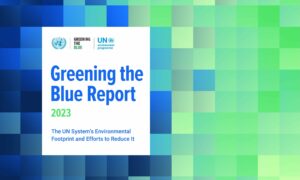
The UN System’s Environmental Footprint | Findings of the Greening the Blue Report 2023
9 February 2024 | 15:30 – 17:00
Sustainable United Nations & GEN
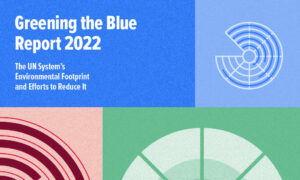
The UN System’s Environmental Footprint | Presenting the findings of the UN Greening the Blue Report 2022
9 February 2023 | 16:00 – 17:00 CET
Sustainable United Nations & GEN
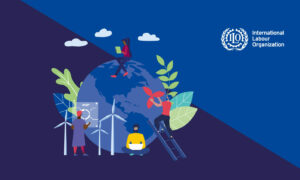
Launch | ILO Environmental Sustainability Action Plans 2018-21
29 October 2020 | 9:30–10:30 CET
ILO & GEN




